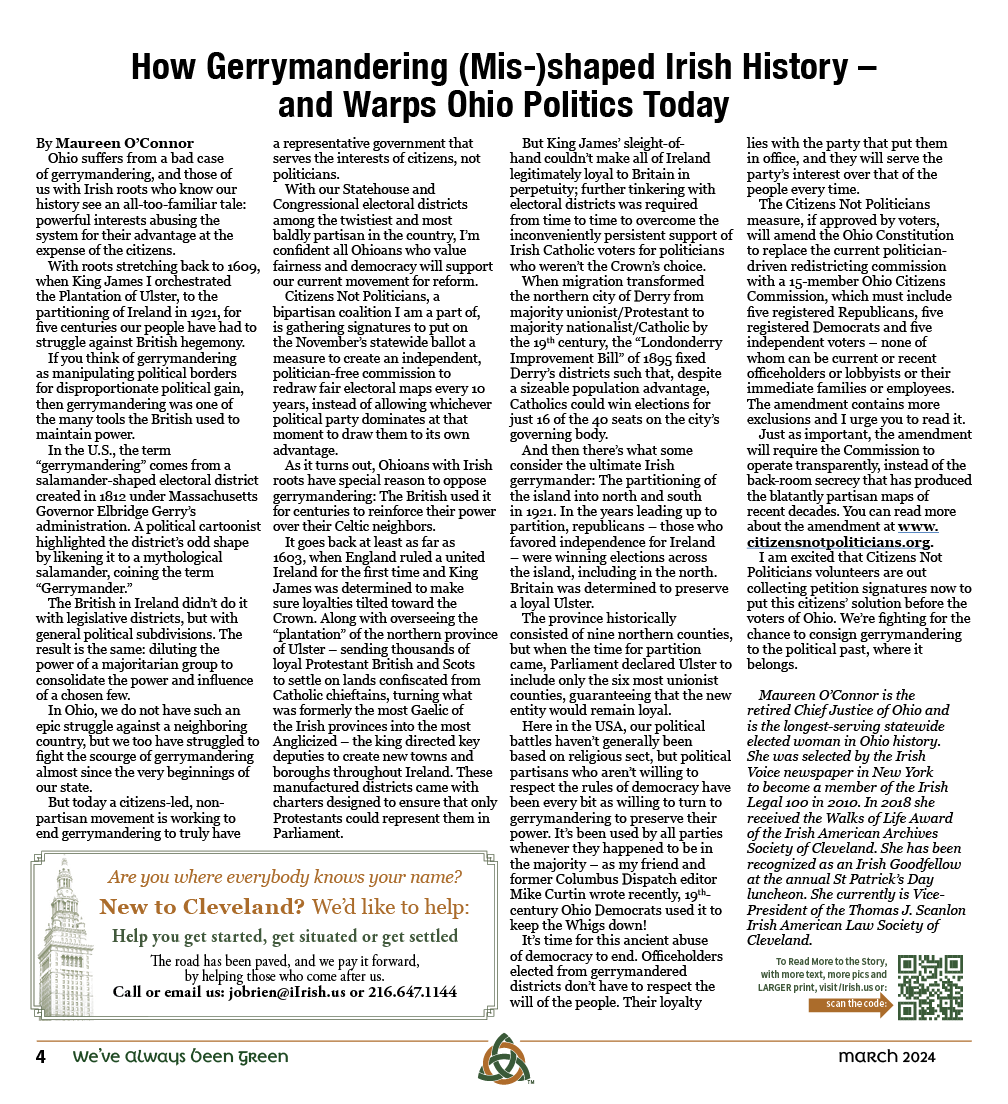
By Maureen O’Connor
Ohio suffers from a bad case of gerrymandering, and those of us with Irish roots who know our history see an all-too-familiar tale: powerful interests abusing the system for their advantage at the expense of the citizens.
With roots stretching back to 1609, when King James I orchestrated the Plantation of Ulster, to the partitioning of Ireland in 1921, for five centuries our people have had to struggle against British hegemony.
If you think of gerrymandering as manipulating political borders for disproportionate political gain, then gerrymandering was one of the many tools the British used to maintain power.
In the U.S., the term “gerrymandering” comes from a salamander-shaped electoral district created in 1812 under Massachusetts Governor Elbridge Gerry’s administration. A political cartoonist highlighted the district’s odd shape by likening it to a mythological salamander, coining the term “Gerrymander.”
The British in Ireland didn’t do it with legislative districts, but with general political subdivisions. The result is the same: diluting the power of a majoritarian group to consolidate the power and influence of a chosen few.
In Ohio, we do not have such an epic struggle against a neighboring country, but we too have struggled to fight the scourge of gerrymandering almost since the very beginnings of our state.
But today a citizens-led, non-partisan movement is working to end gerrymandering to truly have a representative government that serves the interests of citizens, not politicians.
With our Statehouse and Congressional electoral districts among the twistiest and most baldly partisan in the country, I’m confident all Ohioans who value fairness and democracy will support our current movement for reform.
Citizens Not Politicians, a bipartisan coalition I am a part of, is gathering signatures to put on the November’s statewide ballot a measure to create an independent, politician-free commission to redraw fair electoral maps every 10 years, instead of allowing whichever political party dominates at that moment to draw them to its own advantage.
As it turns out, Ohioans with Irish roots have special reason to oppose gerrymandering: The British used it for centuries to reinforce their power over their Celtic neighbors.
It goes back at least as far as 1603, when England ruled a united Ireland for the first time and King James was determined to make sure loyalties tilted toward the Crown. Along with overseeing the “plantation” of the northern province of Ulster – sending thousands of loyal Protestant British and Scots to settle on lands confiscated from Catholic chieftains, turning what was formerly the most Gaelic of the Irish provinces into the most Anglicized – the king directed key deputies to create new towns and boroughs throughout Ireland. These manufactured districts came with charters designed to ensure that only Protestants could represent them in Parliament.
But King James’ sleight-of-hand couldn’t make all of Ireland legitimately loyal to Britain in perpetuity; further tinkering with electoral districts was required from time to time to overcome the inconveniently persistent support of Irish Catholic voters for politicians who weren’t the Crown’s choice.
When migration transformed the northern city of Derry from majority unionist/Protestant to majority nationalist/Catholic by the 19th century, the “Londonderry Improvement Bill” of 1895 fixed Derry’s districts such that, despite a sizeable population advantage, Catholics could win elections for just 16 of the 40 seats on the city’s governing body.
And then there’s what some consider the ultimate Irish gerrymander: The partitioning of the island into north and south in 1921. In the years leading up to partition, republicans – those who favored independence for Ireland – were winning elections across the island, including in the north. Britain was determined to preserve a loyal Ulster.
The province historically consisted of nine northern counties, but when the time for partition came, Parliament declared Ulster to include only the six most unionist counties, guaranteeing that the new entity would remain loyal.
Here in the USA, our political battles haven’t generally been based on religious sect, but political partisans who aren’t willing to respect the rules of democracy have been every bit as willing to turn to gerrymandering to preserve their power. It’s been used by all parties whenever they happened to be in the majority – as my friend and former Columbus Dispatch editor Mike Curtin wrote recently, 19th-century Ohio Democrats used it to keep the Whigs down!
It’s time for this ancient abuse of democracy to end. Officeholders elected from gerrymandered districts don’t have to respect the will of the people. Their loyalty lies with the party that put them in office, and they will serve the party’s interest over that of the people every time.
The Citizens Not Politicians measure, if approved by voters, will amend the Ohio Constitution to replace the current politician-driven redistricting commission with a 15-member Ohio Citizens Commission, which must include five registered Republicans, five registered Democrats and five independent voters – none of whom can be current or recent officeholders or lobbyists or their immediate families or employees. The amendment contains more exclusions and I urge you to read it.
Just as important, the amendment will require the Commission to operate transparently, instead of the back-room secrecy that has produced the blatantly partisan maps of recent decades. You can read more about the amendment at www.citizensnotpoliticians.org.
I am excited that Citizens Not Politicians volunteers are out collecting petition signatures now to put this citizens’ solution before the voters of Ohio. We’re fighting for the chance to consign gerrymandering to the political past, where it belongs.
Maureen O’Connor is the retired Chief Justice of Ohio and is the longest-serving statewide elected woman in Ohio history. She was selected by the Irish Voice newspaper in New York to become a member of the Irish Legal 100 in 2010. In 2018 she received the Walks of Life Award of the Irish American Archives Society of Cleveland. She has been recognized as an Irish Goodfellow at the annual St Patrick’s Day luncheon. She currently is Vice-President of the Thomas J. Scanlon Irish American Law Society of Cleveland.


Monthly newsmagazine serving people of Irish descent from Cleveland to Clearwater. We cover the movers, shakers & music makers each and every month.
Since our 2006 inception, iIrish has donated more than $376,000 to local and national charities.
GET UPDATES ON THE SERIOUS & THE SHENANIGANS!